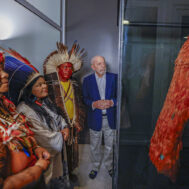The Committee for Cultural Policy[1] and Global Heritage Alliance[2] jointly submitted this testimony on the Proposed Memorandum of Understanding (MOU) for the imposition of import restrictions between the United States and the Republic of Tunisia.
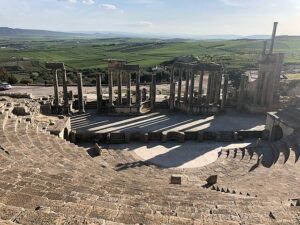
Roman theater in Tunisia, Author Ziad El Shurafa, 20 February 2019, Creative Commons Attribution-Share Alike 4.0 International license.
Both the Committee for Cultural Policy and Global Heritage Alliance support the Congressionally mandated application of the 1983 Cultural Property Implementation Act (CPIA).[3] However, both organizations object strongly to the imposition of import restrictions that will not only fail to positively impact the situation on the ground in Tunisia, but which will harm U.S. stakeholders, including museum organizations, heritage associations, art collectors and religious communities, especially religious minorities whose families lived in Tunisia.
Insignificant evidence of either looting or sale of items from Tunisia
The Public Summary of the request by Tunisia has not established that there is significant looting of Tunisian sites today or that the few items from Tunisia identified as for sale are the products of looting or even from Tunisia at all. For U.S. sales of “Tunisian” objects, the Public Summary cites only to:
- “fragments of vases from Carthage (Punic North Africa more specifically)
- coins… sold at relatively low prices
- lithic Neolithic productions, described as coming from North Africa
- some pieces of Berber jewelry
- an Islamic manuscript.”
Blanket Restrictions Were Never Contemplated by Congress

Ancient Roman Mosaic in Utica, Tunisia, Author Kritzolina, 7 June 2019, Creative Commons Attribution-Share Alike 4.0 International license.
Yet despite the paucity of evidence for trade in possibly Tunisian objects, the Tunisian request seeks import restrictions on:
“…archaeological materials beginning in the prehistoric periods (ca. 200,000 BCE), particularly for stone tools. Archaeological materials include stone (architectonic elements; sculpture; monuments, some with inscriptions in Punic, Greek and Latin; stele, funerary monuments and votives; burial urns and vessels); metal (statuary, coins, reliefs, vessels, jewelry and other items for adornment, seals, tools, weapons and armor); ceramic (sculpture, architectural decoration, figurines, pottery, oil lamps, Medieval glazed pottery); glass, faience and semi-precious stone (architectural elements, vessels, beads and mosque lamps); mosaics (floor, wall and ceiling mosaics); painting (Neolithic rock art and wall paintings); plaster; textiles; basketry; small statuary and personal ornaments of bone, ivory, shell and other organic materials; and human remains. These date up to 1750 CE, spanning the Punic, Greek, Roman, vandal, Byzantine, Islamic and Ottoman periods.”
“Ethnological materials from 1574 to 1811 representing the Ottoman, Amazigh/Berber, Toubou and Tuareg cultures. Ethnological materials include stone (architectural elements, relief sculpture, burial containers, inscriptions typically in Arabic script, vessels); metal (architectural elements, relief sculpture, vessels, jewelry and personal adornments, weapons, ceremonial paraphernalia, such as Koran boxes, and tools); ceramic and clay (architectural decoration, vessels, oil lamps and molds); wood (architectural elements, relief sculpture, vessels, Islamic study tablets and printing blocks in Arabic); bone and ivory, glass, textiles (including religious garments, rugs, and tapestries); leather and parchment (books and manuscripts, including Koranic and other Islamic books and manuscripts); and musical instruments.”

Map of the Ottoman Empire and adjacent regions of the Middle East 1654, United States Library of Congress’s Geography & Map Division, digital ID g7430.ct004264.
Blanket restrictions on objects that are neither currently threatened by looting nor demonstrated to be illicitly trafficked in the U.S. were never contemplated by Congress, either in the legislation or in the Congressional hearings on the CPIA.
On the contrary, Professor James Fitzpatrick, an expert on cultural property law who was personally involved in the negotiations in Congress that resulted in passage of the CPIA, has noted,
“…On their face, wall-to-wall embargoes fly in the face of Congress’ intent.[4] Congress spoke of archeological objects as limited to “a narrow range of objects…”[5] Import controls would be applied to “objects of significantly rare archeological stature…As for ethnological objects, the Senate Committee said it did not intend import controls to extend to trinkets or to other objects that are common or repetitive or essentially alike in material, design, color or other outstanding characteristics with other objects of the same type…[6]”
“Ottoman” artifacts are not properly classified as ethnological items under the CPIA
Under the administration of the State Department, the U.S. has enacted Memoranda of Understanding (MOUs) with foreign nations that recognize those nation’s claims to virtually all cultural property, including the personal property of individuals and the communal property of religious and ethnic groups.

The Ottoman fleet attacking Tunis at La Goulette, Braun and Hogenberg 1574, public domain, Wikimedia Commons.
Through the listing of minority peoples’ books, furnishings, textiles and even religious paraphernalia on Designated Lists, and by the inclusion of common antique objects well into the 19th century under a misapplied classification of “ethnographic” objects under the CPIA, the United States has implicitly recognized the authority of oppressive nationalist regimes in the Middle East to control historical objects associated with Jewish and Christian communities, as well as the art and the ordinary craft production of minority peoples such as Tuareg and Berbers. (Tunisia’s Jews are for the most part an indigenous minority, whereas the 30,000 Christians in Tunisia are almost all relatively recently-arrived foreigners, primarily Roman Catholics.)
The proposed agreement with Tunisia, based upon the Summary written by the Department of State, appears to repeat this erroneous reading of the CPIA to cover the possessions and heritage of Jewish minority populations under the deceptive title of “Ottoman.” This is a general term which may apply to a wide range of commercial products produced within multiple Mediterranean countries during the lengthy period of Ottoman rule. Unquestionably manufactures rather than ethnographic objects, these items were made by and sold to the religiously diverse and multi-ethnic populations of the major towns of the Middle East and North Africa. Ottoman-style goods, wherever produced, are the products of urban cultures and they cannot be characterized as ‘ethnographic’ under the CPIA.
Jewish minority communities will suffer from the proposed import restrictions
A key issue with imposing import restrictions on historical possessions said to be from Tunisia is that almost all of the Jewish artifacts associated with Tunisia belong to people who have been pressured and even forced to leave the country. It would be unconscionable to block transfer of Tunisian Jewish artifacts from Europe or Israel to Tunisian Jews living in the U.S. today, or to return such objects to the Tunisian government, simply because there could be insufficient documentation of the amount of time they have been outside that country.
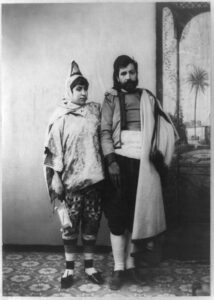
Jewish woman and husband, Tunis, Tunisia, about 1900, Frank and Frances Carpenter Collection, Library of Congress.
Eighteen prominent Jewish organizations have raised concerns about similarly overbroad import restrictions on urban Jewish possessions and religious artifacts. In a December 8, 2018 letter to Secretary of State Mike Pompeo, they strongly objected to these objects being deemed owned by nation states rather than communities under cultural property agreements granted to MENA countries.[7]
A wall of import restrictions across the Middle East has already impacted the region’s former Jewish community, which was expelled and its property confiscated by Syrian, Iraqi, Libyan, Algerian, Tunisian and Egyptian governments in the mid-twentieth century. Too often, import restrictions under the CPIA have exclusively benefited national governments and their claims to own and control cultural and religious artifacts at the expense of the ownership rights and basic human rights of individuals in minority communities.
The tiny communities of Tunisian Jews, numbering today only about 1700, still constitute the largest indigenous religious minority in Tunisia.[8] Jews have lived in Tunisia since at least the Punic era and maintained distinct communities there for many centuries. For the most part, their lives paralleled those of their Arab neighbors. Some, living in the eastern regions adopted a Berber-like lifestyle, others were peasant farmers, smiths and small craftsmen.
The Jewish communities in Tunisia alternately suffered and thrived under various Islamic rulers.
Urban Jews connected to the international trade of the time lived well but often not securely and while they occasionally rose to high positions as advisers and doctors to Muslim rulers from the 9th century onward, at various periods during the Ottoman era it was convenient for local rulers to scapegoat them. The Tunisian Jewish community was periodically augmented by immigration of Jews from Spain and Portugal when repression by Christians there increased.
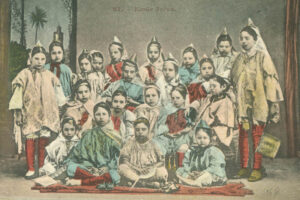
Jewish School, postcard, Wikimedia Commons.
The advent of European colonialism exacerbated stresses between the Jewish and Muslim population; Tunisian Jews were seen as benefiting by and sympathetic to European powers. Jews were given greater rights under the French Protectorate until the Vichy rule in Fascist France, when Nazi occupiers arrived in 1942. After the war, many Jews left together with the French in 1956, when the Protectorate ended.
Jews left Tunisia en masse in the 1960s, about half going to Israel and half to France, some heading in boats to Marseilles after the hostilities in 1961 when Tunisia blockaded French ships at their naval base in 1961. Many more left after the Six-Day War in 1967, when rioting broke out and the great synagogue in Tunis was set on fire.[9] The Jewish population was reduced from 105,000 in 1948 to only about 1100 persons in 2018. Jews lived mainly in Tunis, with communities on the island of Djerba.
Tunisia’s reputation is one of greater tolerance today. Nonetheless, Tunisia’s last remaining intact Jewish community in Djerba is also preparing to depart, taking with them the bones of their ancestors in order to avoid risking the desecration of cemeteries that has occurred in other Muslim states.[10] While many seek a fuller life for their families, the community is also fearful of recent terror attacks that have taken place less than a hundred miles away.
The vast majority of valuable artworks and artifacts from Tunisia sold in the U.S. are Jewish religious objects, not antiquities
We have reviewed the sales of all artworks identified as probably Tunisian in origin at Sotheby’s New York available online. These auctions took place between 2006 and 2017. Every single item was Judaica. All items were from the late 19th to early 20th century.
Among them were:
- A pair of large north African silver Torah finials, Tunisia, early 20th century, sold $5,000
- A North African rose gold and diamond Torah pointer, Tunisia, 1905-17, sold $15,000
- North African gold Hanukah lamp, Tunisia, dated 1923, sold $20,000
- A pair of North African silver large Torah finials, possibly Tunisia, early 20th century, sold $8,000
- A Tunisian gold miniature Hanukah lamp, circa 1930, sold $4,750
- A pair of North African silver large Torah finials, possibly Tunisia, early 20th century, unsold at $6,000
- A pair of North African silver Torah finials, probably Tunisian, circa 1900, sold $7,500
- A Tunisian wrapping cloth for Torah scroll case
circa 1900, sold $5313 - A North African silver hanging memorial lamp with Hebrew inscription, Moroccan or Tunisian, dated 1899, sold $2125
The auction house Christie’s had only one offering on record from Tunisia in the tens of thousands of objects sold in its New York sale rooms. This was in a lot of four gold, silver-gilt and gilt-metal boxes of various dates and makers. One of the four boxes was from Tunisia, 20th century. All four sold for $2,750.
A few dozen objects in more than a decade sold at the major U.S. auction houses, all but one item being Jewish religious ornaments, does not equate with a market of any significance whatsoever in the U.S. for Tunisian antiquities.
Coins

Tunisian fals (burbe) – 1173 AH – 1760 AD – Ottoman Sultan Mustafa III khan (weight 3,40 g, Diameter 21 mm, thickness 1,6 mm), Author DrFO.Tn. 8 August 2019, Creative Commons Attribution-Share Alike 4.0 International license.
Coins are among the most common and generally the least valuable ancient artifacts. They are the artifacts most often found, having been dropped and not missed in ancient sites, or found in small hoards that were hidden away from invaders or marauding bands in war and times of instability. In respect to coins, we defer to experts such as Mr. Peter Tompa for the facts on the wide, international distribution of the coin types found in Tunisia.[11]
In his testimony, Mr. Tompa notes that the critical issue is whether it is proper to assume coins of types struck or sometimes found in Tunisia were in fact “first discovered” there so that they would be subject to Tunisian “export control.”
He states: “Indeed, this is particularly true for the imperial mint at Carthage. That mint (or mints) issued huge numbers of coins for the Carthaginians, the Romans, the Vandals, and the Byzantines. Such imperial issues were never intended to circulate only within the confines of modern-day Tunisia. Indeed, scholarly evidence demonstrates that ancient “Tunisian” coins—with the possible exception of some local bronze civic issues — are often found outside of the confines of modern day “Tunisia,” which would make any restrictions imposed upon them solely predicated on where they were made or are sometimes found contrary to the CPIA’s statutory intent.”[12]
The frequent impossibility of determining the findspot rather than the mint of coins in order to meet the legislative criteria under the CPIA is a key reason why CPAC has voted against the inclusion of coins in Designated Lists in the past. This occurred most dramatically in the case of Cyprus in 2007. Despite CPAC’s recommendation to exclude coins, the State Department rejected that recommendation and then misled the Congress and the public about it.[13] The late Jay Kislak, who was Chairman of CPAC at the time, affirmed this in a sworn court declaration. As Mr. Tompa’s extensive analysis in his comments on the Tunisia request makes clear, this is another situation in which the facts cannot justify any restriction on coins.
Ethnographic materials called Tuareg and Berber are (1) not subject to restriction under the “ethnological” category in the CPIA and are (2) far more likely to originate in other nations with much larger populations

Berber, Tunisia, Author Paralingua, 23 August 2007, Wikimedia Commons, GNU Free Documentation License.
Tunisia has demanded U.S. import restrictions and return of ethnological objects of the Tuareg and Berber minorities. The Summary proposes that the U.S. grant import restrictions over the ordinary craft production of these Saharan tribal peoples, apparently ignoring the fact that almost none of this material can be dated to before the mid-19th century.
The Tunisian Request covers ethnographic materials up to the year 1811, made from stone, metal, ceramic and clay, wood, bone and ivory, glass, textile, basketry and rope, leather and parchment, and writing. This element of the Tunisian Request in no respect comports with Congress’ criteria for restrictions on ethnographic materials of particular meaning to a pre-industrial community as envisioned by the drafters of the CPIA.
The items created and used by the nomadic Berber and Tuareg are household goods and decorative garments, bags, and jewelry that is subject to ordinary wear and tear and much hard usage. Because of this hard usage, there is very little nomadic material culture remaining anywhere in Africa that is older than the late nineteenth century. The oldest items will all have been exported from one of the eight or more source countries in which the Tuareg and Berber have lived at least ten years (and more likely many decades) before and would not be subject to import restrictions under the provisions of the Cultural Property Implementation Act.
The CPIA requires that ethnographic material have some important character: “No object may be considered to be an object of ethnological interest” unless the object is “important to the cultural heritage of a people because of its distinctive characteristics, comparative rarity, or its contribution to the knowledge of the origins, development, or history of that people.”[14]
That is not the case here. The goods made by the Tuareg and Berber were household goods made to sell; these nomadic traders have made and traded goods to their Saharan neighbors as a business for as long as there has been documentation of their existence. Their goods are widely distributed already; since the 1960s, Tuareg and Berber folk art and crafts have been very popular in Europe, the UK, and the US.
There are estimated to be between 110,000-390,000 Berbers in Tunisia, compared to:
- Morocco: 10-12 million
- Algeria: 9-13 million
- Libya: 3,500,000[15]
There are actually 5-10 times more Berbers in France today than in Tunisia.
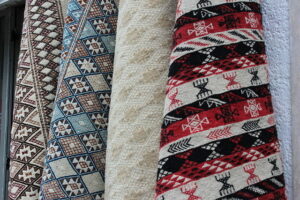
Carpets containing Berber symbols from Takrouna, a Berber village in Tunisia. Author Sami Mlouhi, 22 November 2015, Creative Commons Attribution-Share Alike 4.0 International license.
There is only a very small population of approximately 2000 Tuareg in Tunisia. The vast majority live, work and trade in other African nations.
- Niger: approximately 2 million[16]
- Mali: approximately 0.5 million[17]
- Burkina Faso: 370,738[18]
- Algeria: 25,000–150,000 (1987)
- Tunisia: 20,000 (1993)[19]
- Morocco: 4,500 (1984) (nomadic)
- Tunisia: 2,000 (1987) (nomadic)
- Mauritania: estimated 100,000[20]
It would not be possible for U.S. Customs to distinguish the production from these different nations’ populations.
Import Restrictions Must Be of Substantial Benefit in Deterring a Serious Situation of Pillage
A measure of whether an MOU with the U.S. would reduce the jeopardy of pillage is whether there is a market in pillaged material in the state that is being asked to impose import restrictions. Section 303(a)(1)(C) of the CPIA states that U.S. import restrictions may be implemented only if:
“the application of the import restrictions set forth in section 307 with respect to archaeological or ethnological material of the State Party, if applied in concert with similar restrictions implemented, or to be implemented within a reasonable period of time, by those nations (whether or not State Parties individually having a significant import trade in such material, would be of substantial benefit in deterring a serious situation of pillage…)”
The Tunisian request fails to show that the United States is a significant market for recently looted Tunisian antiquities. The auction records for objects of Tunisian heritage above confirm that it is not.
There is no question of Jewish religious items or Berber household goods being looted. The Tunisian request is illustrated by a half-dozen examples of ostensibly looted materials, with the exception of coins. It does not show that there is any significant market for recently looted Tunisian antiquities anywhere. Nor does it demonstrate that U.S. import restrictions will have a significant effect in preventing current looting in Tunisia.
The request failed to mention that corruption in the former Tunisian government was responsible for prior looting and illicit sales

Photochrome print from “Views of Architecture and People in Tunisia” from the catalog of the Detroit Photographic Company. It shows a private drawing room in the Kassar-Said Palace in Tunis, circa 1899. US Library of Congress.
It is worth noting that there is almost nothing in news coverage in the last decade on looting or smuggling of art or antiquities from Tunisia except by highly placed, corrupt officials and their family members. Sakher el-Materi, the affluent son-in-law of ousted president Zine el-Abidine Ben Ali, reportedly used Tunisian antiquities taken from Tunisia’s museums to decorate his many villas.The family of former Tunisian rulers were also deeply involved in trafficking of antiquities according to media reports. According to the online bulletin of ARCS, the Association of Registrars and Collection Specialists, “a fifth century statue of Ganymede was stolen from the Carthage Paleo-Christian Museum in the capital of Tunis.. Museum guards were arrested in connection with the theft, but the mastermind remains unknown…. the prevalence of bribery and pervasive negligence of the authorities threaten the safety of artifacts now.”[21]
According to the same article, Youssef Cherif, a blogger and a specialist in ancient history and archaeology stated that, “Customs officers do not care about artifacts.” This failure by Tunisia to meet the self-help requirements of the CPIA by providing basic education to law enforcement cannot serve as a justification for import restrictions.
Tunisian laws
In general, Tunisia allows private ownership of both antiques and antiquities, although certain objects must be documented, and the state given the option to purchase them when transferred.
The key legislative act is the Law Pertaining to the Code of the Heritage of Archaeology, History and the Traditional Arts (1994, amended 2011). Its provisions include:
- Archaeological, historic or traditional property is part of the public domain of the State, with the exception of that for which private ownership has been determined. (Art.1)
- When movable property belonging to an individual is threatened with defacement or neglect, the Minister Responsible for the Cultural Heritage may order protection. (Art. 52)
- All or part of any movable or immovable remains found on the soils or removed from the subsoil or an archaeological monument prior to promulgation of this code [1994] may be kept in trust by the individual, along with the responsibility and ensuing servitudes. (Art.94)
- In the event of sale of a privately-owned movable asset, the state may exercise a right of first refusal. (Art. 51)
- Movable property may be subject to a Protection Order made by the Minister Responsible for the Cultural Heritage. (Art.49)
- Export of Movable Cultural Property is prohibited. (Art. 57)
Tunisia’s laws apparently did not strictly restrict export until 1994, they allow private ownership of artifacts discovered prior to 1994, they restrict trade in objects when they are at risk of damage and defacement, and require their registration. The Tunisian request does not explain why it seeks to impose a far more rigorous and restrictive regime on U.S. citizens than it does on its own.
In general, it is the Committee for Cultural Property’s and Global Heritage Alliance’s position that no object that may be traded, transferred or sold legally within Tunisia under its domestic laws should be excluded from import into the United States under a MOU.
Conclusion
Tunisia has not provided evidence that its situation with respect to looting satisfies the determinations required by the Cultural Property Implementation Act. The request describes a trickle of low value items on online auctions and sales sites being offered in Europe, the U.S. and the Middle East, without any showing that these were found in Tunisia specifically – or even that they are authentic. The records show that only Judaica is actually sold in the U.S. at auction.
Mandatory statutory determinations must be based on evidence and facts, not speculation about imaginary markets and an ‘illicit’ goods traffic that can’t even be proved to be authentic or even really to exist. Without having provided the facts substantiating the four determinations, Tunisia does not meet the criteria required by the Cultural Property Implementation Act to justify an MOU. It hardly needs repeating that every one of the statutory criteria must be met in order for the U.S. to implement import restrictions under the Cultural Property Implementation Act.
Under the aegis of the State Department’s Bureau of Educational and Cultural Affairs, import restrictions under the CPIA have provided for near permanent bans on the import of virtually all cultural items from the prehistoric to the present time from the countries which have sought agreements. If CPAC fails to heed the concerns of Congress regarding overbroad import restrictions unsubstantiated by clear evidence of meeting the four determinations, CPAC not only acts in derogation of U.S. law, but also lends support to what Congress feared, an exclusively statist rather than internationalist policy on cultural heritage.
When the CPIA was passed, Congress never indicated that it was in the interest of the United States to block imports of all art and archaeological materials from source countries. Congress contemplated a continuing trade in ancient art except in objects at immediate risk of looting. Nor did Congress state that halting the trade in art was a positive goal. On the contrary, Congress viewed the CPIA as balancing the United States’ academic, museum, business, and public interests by assisting art source countries to preserve archaeological resources and ensure the U.S.’s continuing access to international art and antiques through a relatively free flow of art from around the world.[22]
The Cultural Property Advisory Committee should live by the law that created it. It should apply a plain reading to the four determinations it must make. For almost 20 years, critics of the operation of CPAC by the Department of State (including a number of former members of CPAC) have argued that the agreements and import restrictions under the CPIA are overbroad and have disregarded the requirements of the law.
CPAC should not recommend Memoranda of Understanding with governments that fail to meet the statutory requirements of the CPIA. If limited import restrictions are imposed, it can ensure that the Designated Lists include specific language that exempts the heritage of minority peoples who have been persecuted and exiled, that import restrictions are not imposed on community and personal property that has been seized, disrespected and despoiled. Import restrictions should only be imposed in situations where the facts and the law support them.
Once again, the Committee for Cultural Policy and Global Heritage Alliance respectfully request that Tunisia’s request for import restrictions be rejected, that the full text of the Tunisia request be supplied to the public, and that the public be given a meaningful opportunity to address the range of materials sought to be restricted and the chronological scope of the request.
Thank you very much for your attention. I look forward to speaking with you on January 21, 2020.
Kate Fitz Gibbon, Executive Director, Committee for Cultural Policy, Inc.
[1] The Committee for Cultural Policy (CCP) is an educational and policy research organization that supports the preservation and public appreciation of the art of ancient and indigenous cultures. CCP supports policies that enable the lawful collection, exhibition, and global circulation of artworks and preserve artifacts and archaeological sites through funding for site protection. CCP deplores the destruction of archaeological sites and monuments and encourage policies enabling safe harbor in international museums for at-risk objects from countries in crisis. CCP defends uncensored academic research and urges funding for museum development around the world. CCP believes that communication through artistic exchange is beneficial for international understanding and that the protection and preservation of art is the responsibility and duty of all humankind.
[2] Global Heritage Alliance (GHA) advocates for policies that will restore balance in U.S. government policy in order to foster appreciation of ancient and indigenous cultures and the preservation of their artifacts for the education and enjoyment of the American public. GHA supports policies that facilitate lawful trade in cultural artifacts and promotes responsible collecting and stewardship of archaeological and ethnological objects. The Global Heritage Alliance. 1015 18lh Street. N.W. Suite 204, Washington, D.C. 20036. http://global-heritage.org/
[3] The Convention on Cultural Property Implementation Act, 19 U.S.C. §§ 2601, et seq.
[4] James F. Fitzpatrick, Falling Short – the Failures in the Administration of the 1983 Cultural Property Law, 2 ABA Sec. Int’l L. 24, 24 (Panel: International Trade in Ancient Art and Archeological Objects Spring Meeting, New York City, Apr. 15, 2010).
[5] See Senate Report No. 564, 97th Cong., 2nd Sess. at 4 (1982)
[6] See Senate Report No. 564, 97th Cong., 2nd Sess. at 6 (1982)
[7] Letter to Secretary of State Mike Pompeo Regarding Cultural Property Agreements, Jimena, December 9, 2018, http://www.jimena.org/letter-to-secretary-of-state-mike-pompeo-regarding-cultural-property-agreements/
[8] European Jewish Congress, Tunisia, https://eurojewcong.org/communities/tunisia/
[9] 1967 War – impact on Jews in Arab countries”. www.sixdaywar.co.uk.
[10] Daniella Cheslow, Tunisia’s last Jewish community dreams of a move to Israel “en masse”, The Guardian, June 23, 2016, https://www.theguardian.com/world/2016/jun/23/tunisia-last-jewish-community-djerba-israel
[11] Please see the commentary submitted by Mr. Tompa to this committee regarding the Tunisian request on behalf of the International Association of Professional Numismatists.
[12] Peter K. Tompa, Letter from the International Association of Professional Numismatists (“IAPN”) to the Cultural Property Advisory Committee, January 7, 2020. https://www.regulations.gov/docket?D=DOS-2019-0043. IAPN Comment on Tunisia MOU
[13] Note also Mr. Tompa’s cite to: Ancient Coin Collectors Guild v. U.S. Customs and Border Protection (“ACCG v. CBP”), 801 F. Supp. 2d 383, 407 n. 25 (D. Md. 2011) (“Congress only authorized the imposition of import restrictions on objects that were ‘first discovered within, and [are] subject to the export control by the State Party.”)
[14] 19 U.S.C. §2601(2)(C)(ii)(II).
[15] Berbers, Wikipedia, https://en.wikipedia.org/wiki/Berbers
[16] The World Factbook”. Central Intelligence Agency. Retrieved 2016-10-08., Niger: 11% of 18.6 million.
[17] Pascal James Imperato; Gavin H. Imperato (2008). Historical Dictionary of Mali. Scarecrow. p. lxxvii. ISBN 978-0-8108-6402-3., Tuarag: 3% [of total Mali’s 17.1 million population].
[18] “The World Factbook”. Central Intelligence Agency. Retrieved 2016-10-08., Burkina Faso: 1.9% of 19.5 million.
[19] https://en.wikipedia.org/wiki/Tuareg_people; see also: https://joshuaproject.net/people_groups/15608/LY, both last visited 07/08/2017
[20] https://www.csmonitor.com/World/2012/0802/In-Mauritanian-refugee-camp-Mali-s-Tuaregs-regroup, and https://joshuaproject.net/people_groups/15607/MR, both last visited 07/08/2017.
[21] Negligence, Corruption Threaten Tunisia’s Heritage Sites, ARCS Association of Registrars and Collection Specialists May 4, 2014, https://www.arcsinfo.org/news-events/entry/266/negligence-corruption-threaten-tunisia-s-heritage-sites
[22] 19 U.S.C. § 2602(a)(1)(A-D) and 19 U.S.C. § 2602(a)(4)
 Ancient Roman Mosaic in Utica, Tunisia, Author Kritzolina, 7 June 2019, Creative Commons Attribution-Share Alike 4.0 International license.
Ancient Roman Mosaic in Utica, Tunisia, Author Kritzolina, 7 June 2019, Creative Commons Attribution-Share Alike 4.0 International license. 
